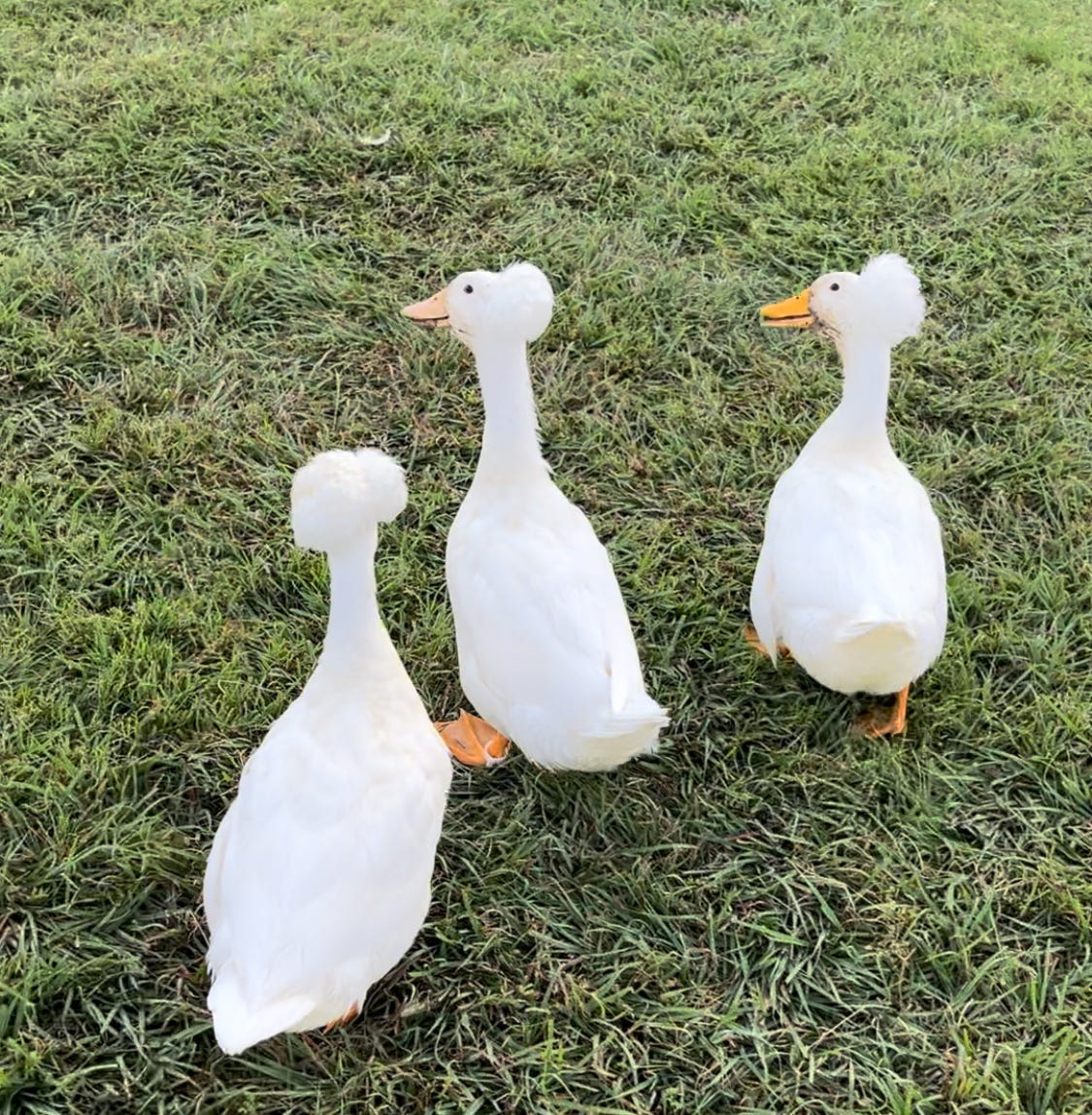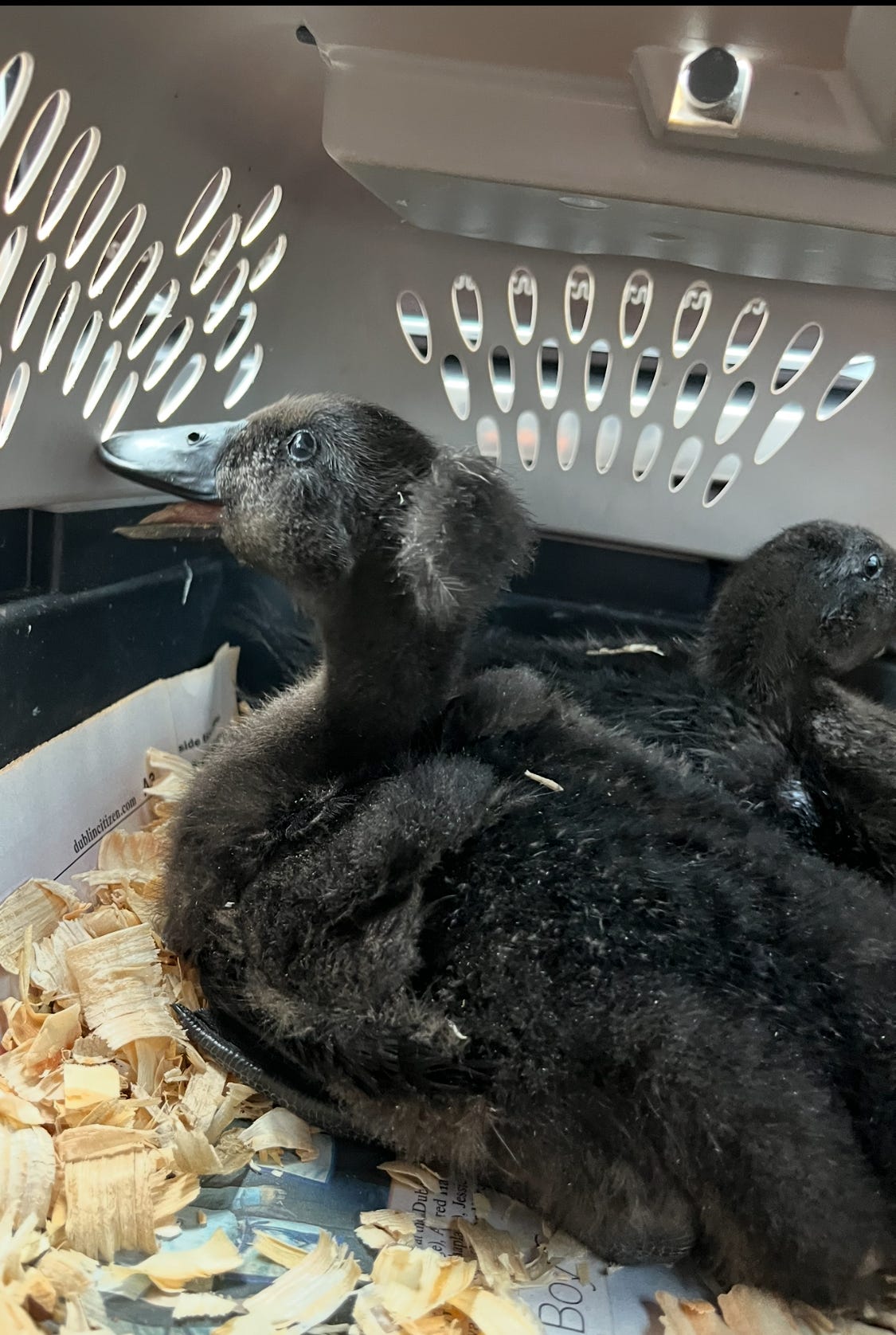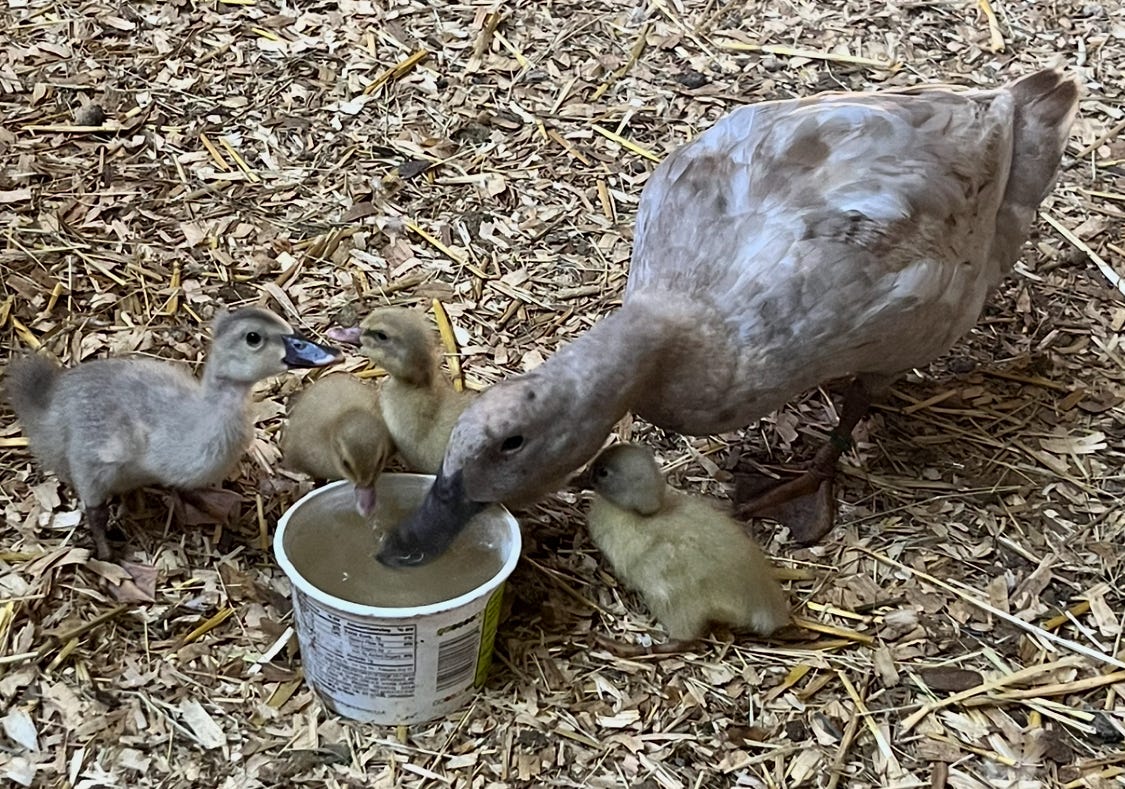Crested ducklings
Duckiemom: Gotta hatch em all!
After over a year of dreaming, planning and pleading with my Crested ladies, I can finally write this post! Instead of a breed detail post [maybe later] , this one focuses on breeding, hatching and identifying Crested ducks.
I had a two-pronged goal for my Cresteds, 1) Develop a Crested Blue Mallard & Apricot Mallard flock and 2) Recreate the Black Crested duck into a flock. I highly suggest before reading more that you brush up on color genetics here.
Crested White ducks are available at multiple hatcheries and sometimes get sent to your local feed store if you’re extremely lucky! This is how I got my Crested group started and 3/4 were females (4th didn’t make it, unknown if male or female). The internet lore about Cresteds is that they’re ornamental, not broody, females get their Crests pulled out while mating and that they’re deadly to breed. I’ll go into more detail later, but will go ahead now and dispel all of those.
My Crested girls lay a large white egg, every day, and usually in the same place [an approved place inside the barn vs my Cayuga Leganés who loves to hide her eggs in the 2.5 acre pasture and moves her nest when I or critters find them]. They have not been broody for the year+ of their life, until very recently when the duck ladies held a secret meeting to all go broody at once and my turkey hens overheard and agreed. At the time of posting, I have Raja duck sitting on Bob’s turkey eggs , Fio duck sitting on 11 turkey eggs while turkey Bill was sitting on four duck eggs [I had to do a ninja switcheroo while Bill was stretching her legs to make sure the correct species was sitting the eggs] and two of my three Crested ladies squished into a nest with one golfball in it [yes, you read that right]. The golfball is a placeholder so I can easily collect their eggs every day, but in their urge to sit, they haven’t noticed their eggs disappear every morning after I arrive and the golfball demands a mother! I do have the wooden fake nest eggs that work well, so well in fact, that several of my hens and my ducks were attempting to sit on them, either preventing them from continuing to lay or causing temperature fluctuations in brooded eggs. So those are literally shelved for now, maybe one day I’ll toss them outside to play a bad trick on the resident crows [they LOVE eggs, but keep hawks away] or the resident skunk [that’ll have to be another post].
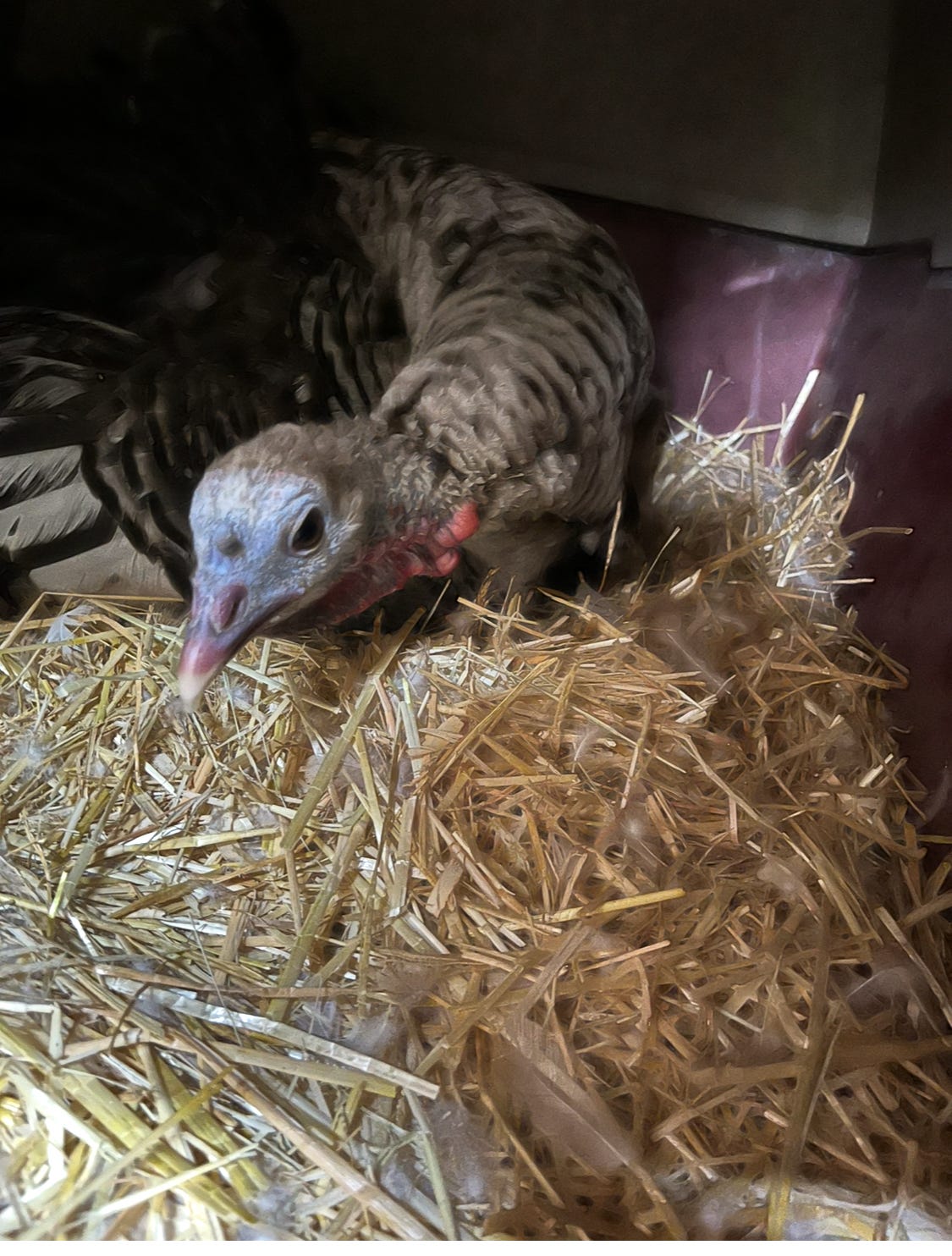
I think my extreme luck at getting so many females from the feed store is because of the third persistent internet lie-lore! lore…that is: males injure female Cresteds by gripping their crest feathers when mating. Hatcheries do a good business selling sexed males because of this myth, since their own crests are way out of the way during mating. I ended up purchasing a sexed Crested White male, to help add the genes I wanted [from a separate hatchery than the one that supplies feed stores, so I’ll get some nice diversity in the bloodlines].
About a month or so ago, I was perusing Craigslist and found a Crested Cayuga! The lady kept apologizing since neither parent has a crest, but I assured her I WANTED the crest, had been trying for a year to breed for it without success so far. After a few weeks, I determined it was a he and Aurélien will be a great addition to the Crested Black program, as well as providing a comparison of inherited (all of my other Cresteds) vs naturally occurring crests.
So, back to the crests during mating issue…my Crested ladies have been laying eggs since October, but none of them had been fertilized until recently, about two months ago. The girls had plenty of fun fake-mating each other, but would all skedaddle as soon as a drake tried to join the party. I was able to hatch a Blue Bibbed (no crest) - only possible if Blue drake Inter was the dad - in the spring.
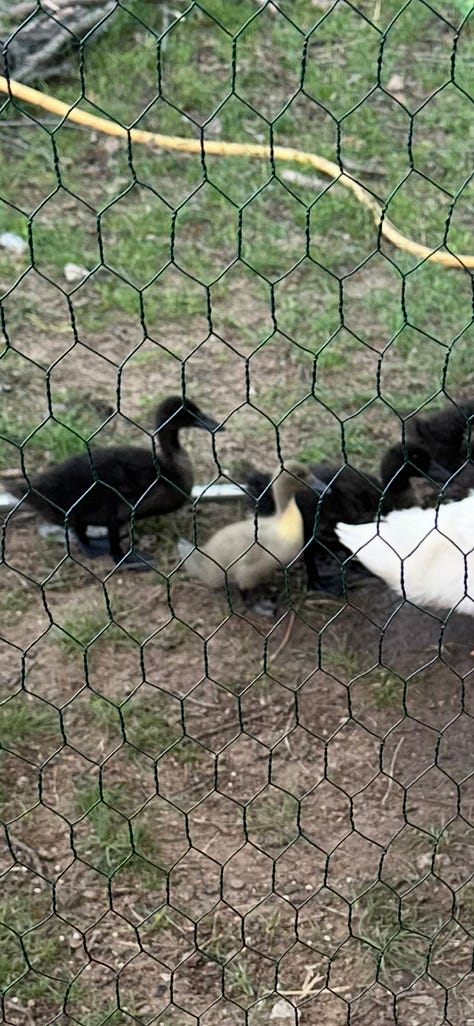
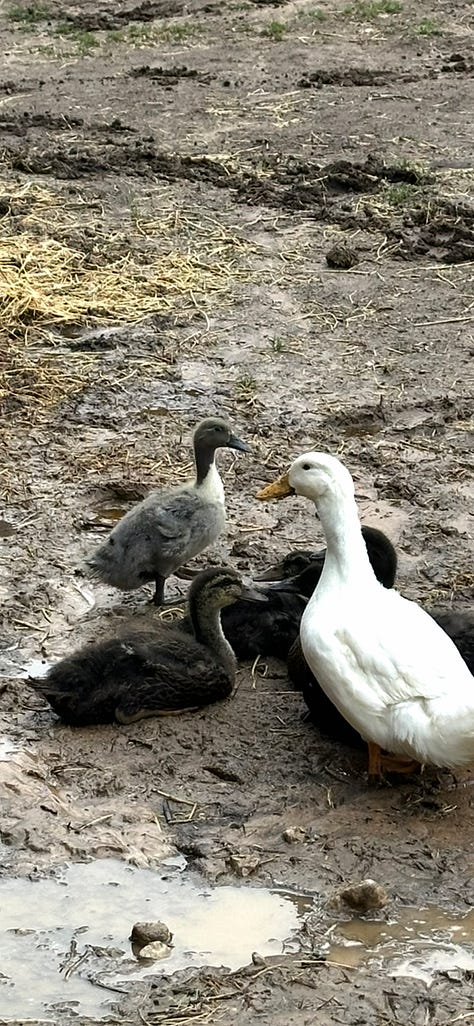
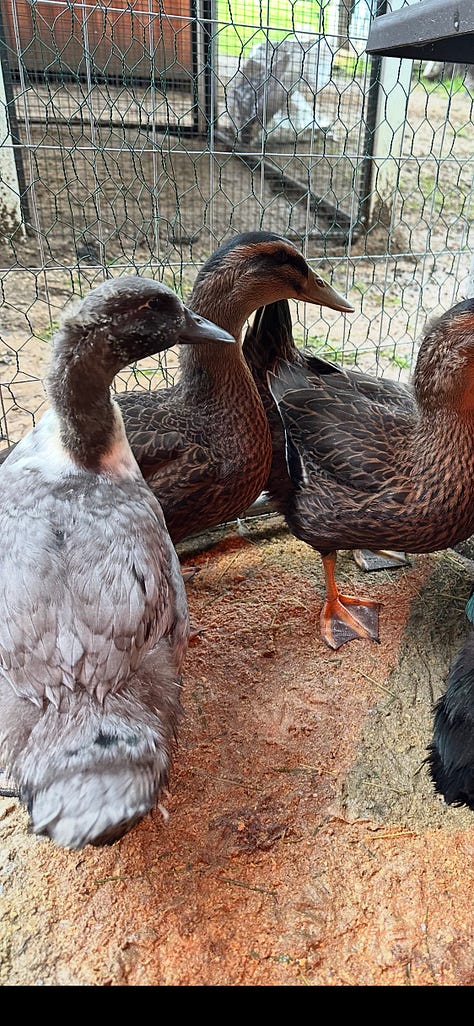
Another hatch from ~10 days ago produced a Black Bibbed (no crest, Cayuga Getafe is the only dad possible) and a finally!! Crested mystery mallard duckling. One of my two Standard Buff drakes is the dad of this duckling and it’s the breeding I’ve been attempting forEVER, without my Crested ladies getting the memo. The most recent hatch from two days ago has finally yielded a lot of hatchlings and a wealth of information that informs this post. I have another batch going as well (end of July hatch), mostly Crested eggs with a few turkey and a Leganés egg that all showed development after the first candling YAY! I had to adjust the flock dynamics some because of the drakes piling up on Leganés, so went from Cayuga Getafe, Blue Inter and three Buff drakes down to Getafe and two Buffs. That seems to have settled things down for Leganés and bumped up the fertility of the Crested eggs. Getafe will occasionally chase the Crested ladies, but he is larger than the Buffs and a bit lazy, so it’s never excessive.
The Buff drakes are smaller and faster and usually find the ladies bathing in the pool where the magic happens. Now that the boys are actually mating the Crested ladies, they have less damage to their crests than when they fake-mate, which left bald spots and floating feathers. I think this is because the boys actually grasp their neck to mate, well below their crest, and once they are done in a few seconds, they let go and move on. The girls’ fake-mating would involve gripping the crest and went on for awhile since it wasn’t accomplishing anything. So, injured ladies during mating? Not any more, or less, than what a good flock manager could and should notice and adjust for. Most duck husbandry sites will quote ad nauseam the ‘correct ratio’ of males to females as being 1 to 4 or 5, but that ratio has never worked for me. Fertility rose when I added another drake or two (a little competition is good for Getafe, I guess) and the most experienced duck around - Leganés at the moment, is the most desirable, especially if she is laying eggs or broody.
Now, for the last and most persistent of Crested myths, that they have a lethal gene and are deadly to breed, that they all have difficult lives, neurological problems and it’s unethical to breed them. You will find quotes all over about two Crest genes causing 25% to ‘die in the shell’, neurological defects and some ducklings hatch without crests, but carry these genes secretly to affect future generations. Since Crested ducks have been around since the 1700s (before dna tests, incubators and color calculators) and all major hatcheries here in the US have them for sale, I am skeptical about these numbers. It is possible one study led to these percentages, but the sample size is way too small to draw conclusions about for every Crested duck in existence. Hatcheries would not invest in breeding something that they lost 25-50% of, much less all of the hatcheries to offer them year round. Here is info from Metzer’s site about their Crested breeding strategy and experience [none of the other hatcheries go into this detail]:

Now that I have a good fertility and hatch rate, I can compile my own data to see if it matches or not. Farther down I will discuss and post detailed color information, but for now the maths of this hatch:
Total eggs set: 18 Crested, 4 Cayuga (for reference)
Eggs removed at 7day candle: 2 (cracked between setting and first candle, but were fertilized). Since I candle before setting, I suspect these eggs might come from a female that lays eggs with weak shells despite having the same nutrition as all of my other ducks, a consideration if I solely kept her for breeding vs eating eggs.
Eggs that did not hatch but were fertilized: 1 Cayuga, 4 Crested. Another Crested was not moving days before hatch, so I did an eggtopsy. It is possible this one could have hatched, but who knows. No crest that I could see.
So a crude percentage would be 30% did not hatch from 22 eggs set = 70% hatch rate. Some breeders will quote their ‘hatch rate’ as close to 100%, but that is just considering the eggs that should hatch and do in the last week of incubation, not eggs that didn’t develop, quit or other issues [oops I dropped one while candling] for not having the number of hatchlings equal to the eggs you put in. I had an egg included in the hatch rate that also had a small crack, but it didn’t seem to penetrate the membrane. I put a small piece of masking tape over it and the duckling pipped at the correct end and hatched successfully. I will probably try and salvage any future cracked eggs this way if it’s not affecting the membrane or embryo. A cracked egg would likely bust way before hatch in the wild, but in the incubator and being monitored, it did ok. If I had been able to tape the shells of those two developing eggs, the percentage would be closer to 78%. Another more difficult way to deal with this would be to determine which duck is laying the weak shelled eggs and eat those instead of hatching them. I keep telling myself that the batch in the incubator is the last hatch…yeah, right.
I don’t have a comparison hatch without Cresteds to compare to, but it seems a very similar, if not even better, percentage based on the many hatches I’ve done from my Cayuga and Buff ducks. If fertilized, the eggs that develop likely hatch. I haven’t had weak shells with those hatches, but a good amount of non fertilized eggs and several quitters for whatever reason. The next batch I have of mixed eggs I candled recently and out of 16 Crested eggs, 1 Cayuga and 4 turkey eggs, only 1 of the Cresteds is debatable since it started developing, but may become a quitter. I’ll update the maths on that hatch later.
Color results: Possibilities from the 11 Crested eggs: Black Bibbed (Swedish), Mallard male, Blue Mallard male (this color is also called Pastel or Blue Fawn), Buff Lilac Mallard female or Buff Chocolate Mallard female. Despite having more drakes that are underage yet, only Cayuga Getafe [Black Bib] and my two Buffs [sex-linked Mallard colors] could be the dad. There is a chance of Crest, No Crest and Crest Genes without a crest. I’ve tried to document and guess at which of the four colors I’m looking at, since documentation of these colors at hatch and as ducks develop is missing from the internet (I’ve searched a lot). For my projects, I do not need to keep the Mallard/Gray pattern or any Bibs, regardless of crest. The Blue Mallard male would ideally need a crest, since without it there’s only a chance he carries the genes and it wouldn’t be evident for six+ months. The females would likely be yellow as ducklings and develop into the brown female mallard as adults, with a nuance of lighter (Lilac) and darker (Chocolate). I can likely keep both of these, even if not crested, since the color genes will be there regardless. Telling them apart at hatch is a wild guess, so I decided to dna test a sampling of the colors to see how it matches to the sex link and my guess at color. I will update in a few weeks when dna results come back.
1 Black Bib, MoF, C (male or female if not sex-linked and crest or no crest visible)
1 Mallard, M, C
2 Blue Mallard, M, NC & C
3 Buff Lilac Mallard, F, 2 C & 1 NC
4 Buff Chocolate Mallard, F, 1 C & 3 NC
Maths for Crests: 54% Crest and 45% No Crest from a C&NC parent breeding. The Crest gene is supposed to be dominant, which is shown here, but by a slim margin.
I decided to dna test one from each of the color patterns I thought there were represented:
‘Borussia’ Mallard male [from the previous hatch, so not included in the maths above since we’re just looking at color here]. This color is semi-dark at hatch, but lightens up as it dries, prominent eye stripes and two-tone feet (brown and orange). With age takes on a grayish hue:

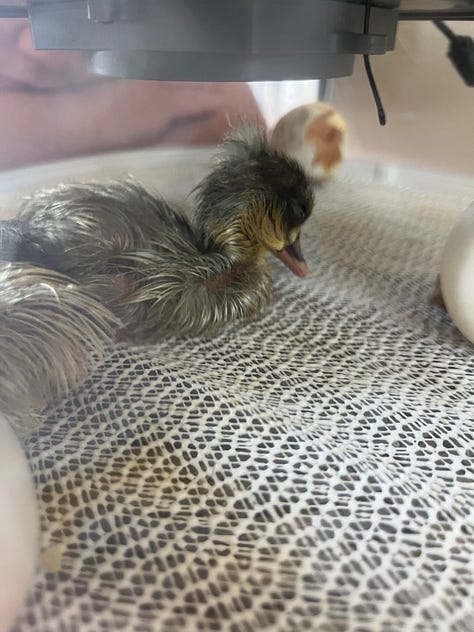
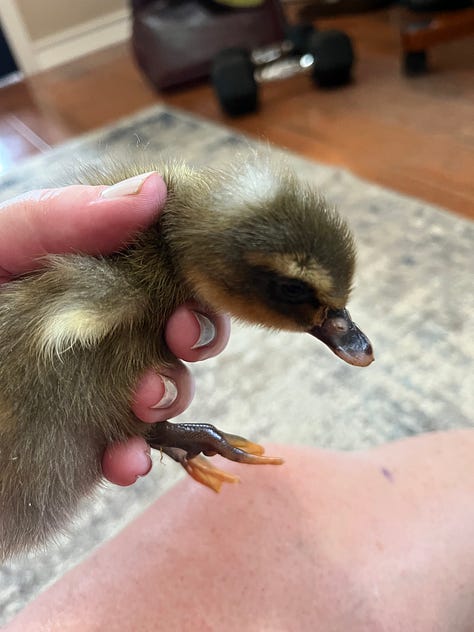
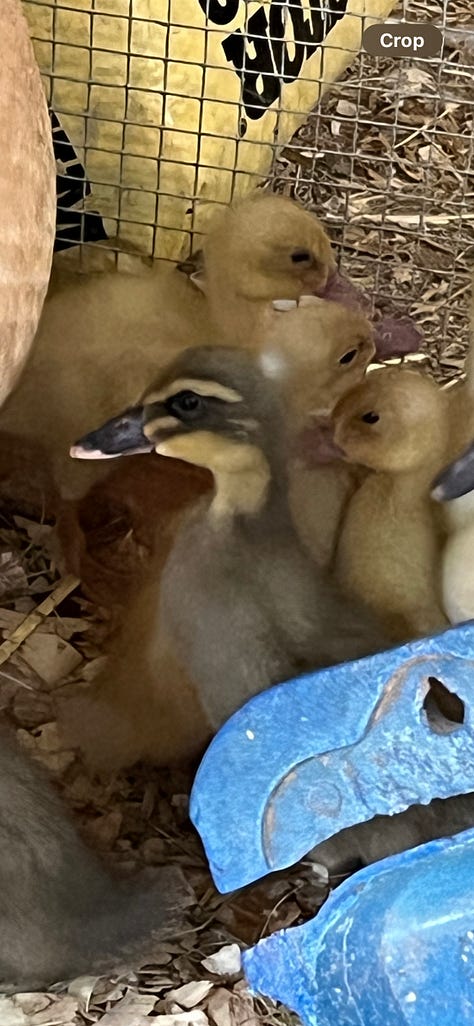
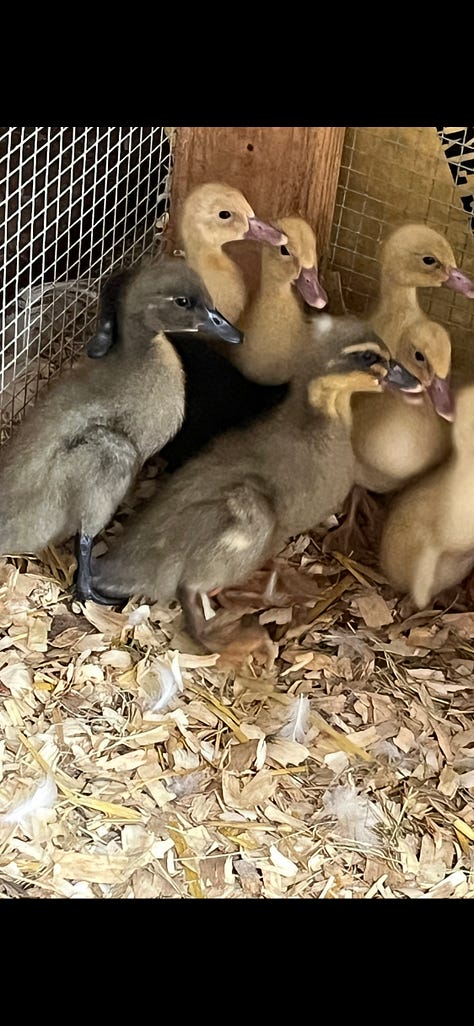
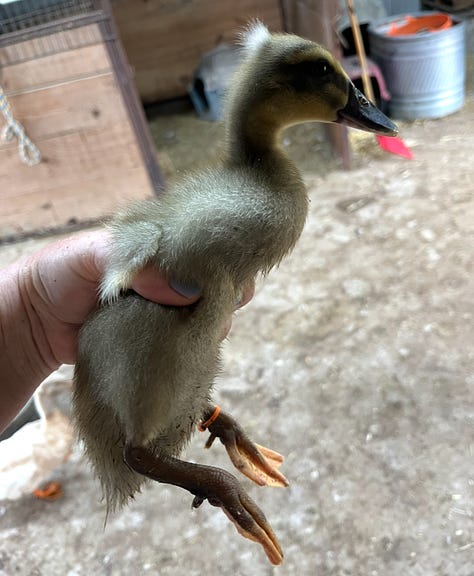
‘Porto’ Blue Mallard male. Dark at hatch and more solid color over the body, yellow underneath. Two-toned feet (black and orange):
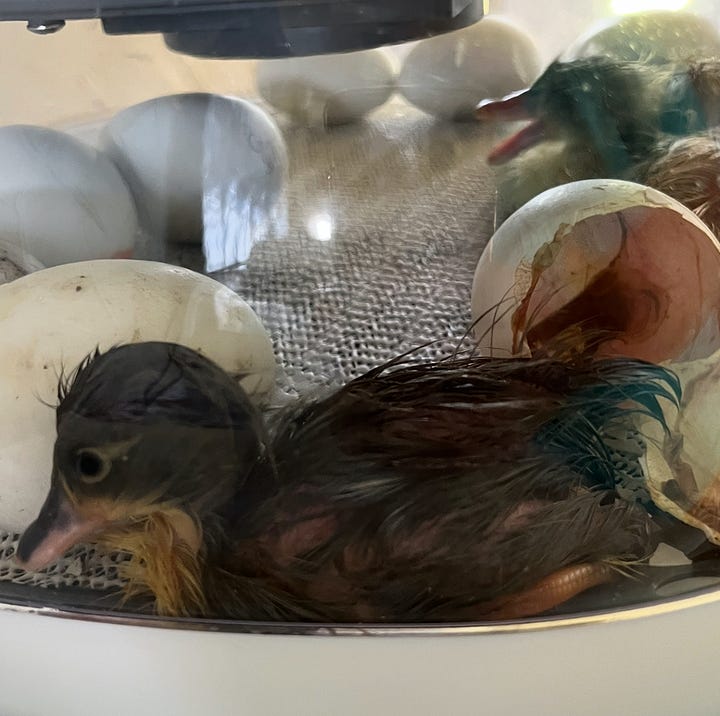

‘Paris’ Chocolate mallard female. These were pretty impossible to tell apart and varied a lot in their coloring, so I chose Chocolate for any that had faint eye stripes or were a deeper tan in color. Feet were orange, with a faint two tone (brown) on some, but not readily observable:
‘Gunner’ Lilac mallard female. Yellow body and any hint of silver anywhere made me choose Lilac for these. Feet were solid orange or very faintly two-toned (dark gray almost black):
The problem child [there’s always one, right?] - taped eggshell duckling - I’m really stumped as to what color to call it, but settled on Lilac mallard. ‘Wrexham’ has a Crest, split in two crests and because she’s been babied will stick around in my flock, but won’t be dna tested. She’s smaller than the rest and hatched last, despite being feisty she is currently separated from the others on a heating pad so she doesn’t get trampled. Her color seems very similar to the eggtopsied duckling that was very light, almost silvery so perhaps it’s just a variation on the Lilac part of the mallard:
Also not keeping or dna testing is the Black Swedish ducklings (2 so far). The older one was not crested, but the one from this batch had a nice sized crest for being from a NC&C breeding:
Second Crested hatch results:
Total eggs set: 16 Crested, 1 Cayuga and 4 turkey
Eggs removed after candling (fertilized but quit before hatch): 7 Crested
Hatch rate: 59% Lower than the first batch with less eggs, but that’s to be expected with these eggs laid later in the hen’s cycle and during higher outdoor temps - even though fertilized, more developed but quit before hatch.
Color/Crest results: For these results, I can add in the two Crested eggs Cayuga Fiorentina hatched in the barn, for results from 11 Cresteds in this second batch:
Mallard: 4 Crested
Blue Mallard: 1 C, 1 NC
Buff Mallard: 5 NC
The Crested rate out of 11 is then 45% and 55% for Non Crested (backwards from the first hatch?).
Next update: DNA test results - will post here soon. [The post office lost my feather samples, so I had to resubmit samples]. Finally - results are in - see below:
Borussia - Crested Mallard Male
At hatch: dark body, two-tone brown and orange legs, prominent eye stripes. As he develops, I initially got nervous about the brown juvenile feathers in along his body, since adult mallard males are supposed to have a silvery gray body, not brown. After researching (the little bit that there is) pictures of juvenile wild mallards, the brown body color is normal while growing and during eclipse plumage as opposed to the drakes’ adulthood and breeding colors, known as nuptial plumage.
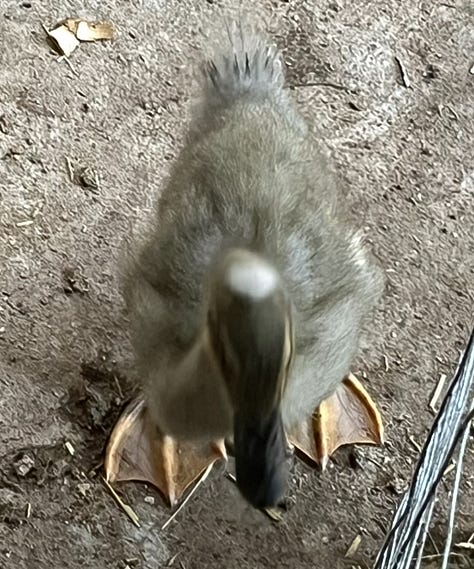
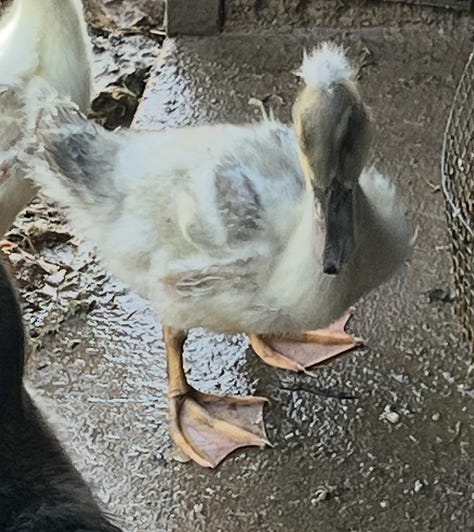
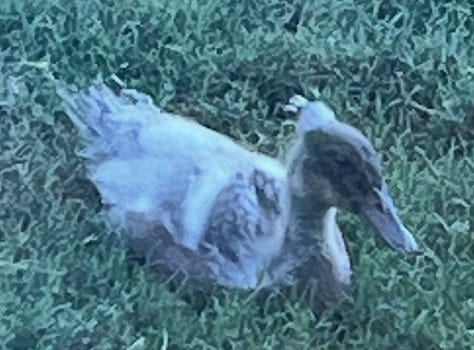
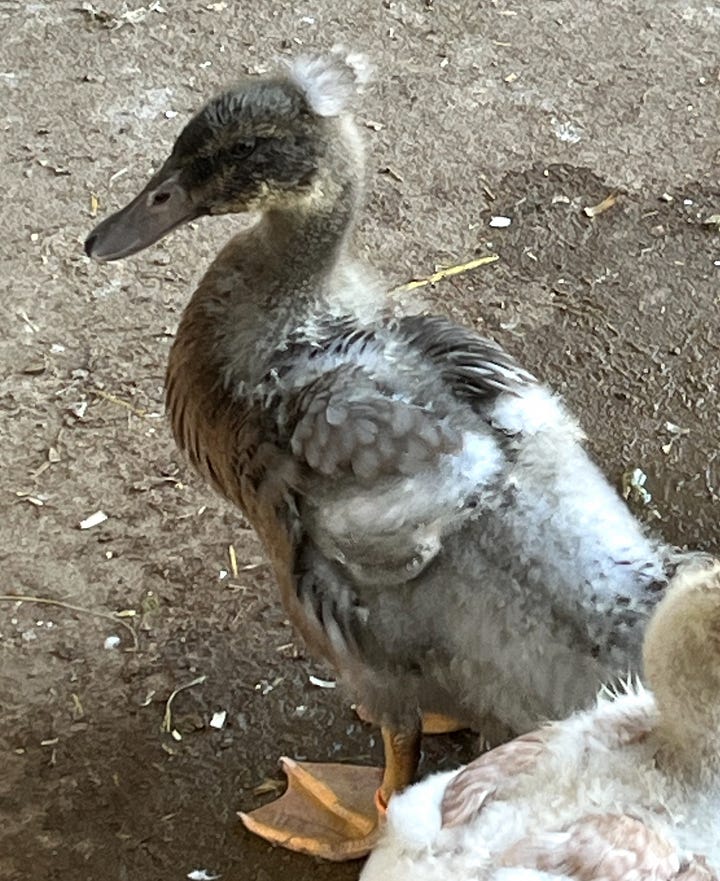
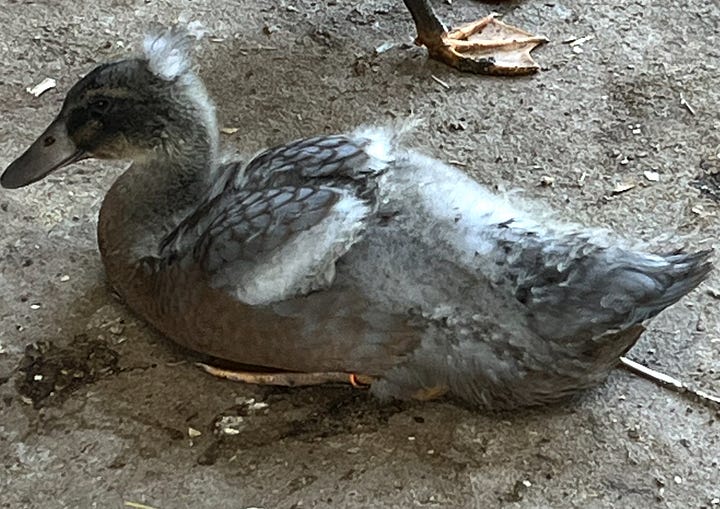
Porto - Crested Blue Mallard (Blue Fawn) Male
Since I was familiar with Blue color ducks from my sex link Cayugas hatch, the Blue mallard pattern was easy to distinguish. A telltale difference from the Mallard (Gray) pattern was two-toned legs that were black and orange. The body color seems to remain a solid grey-blue and the lighter eye circles are present instead of stripes. Bill color is random, since I have hatched other Blue Fawns, crested and not, and the bill color varies amongst them, but stays similar to when they hatch.
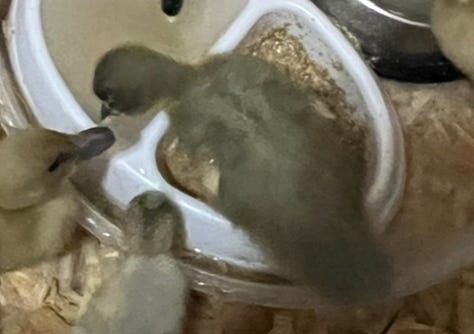
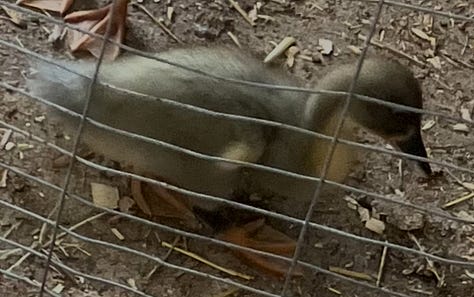
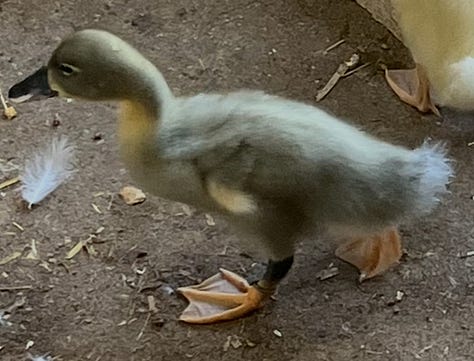
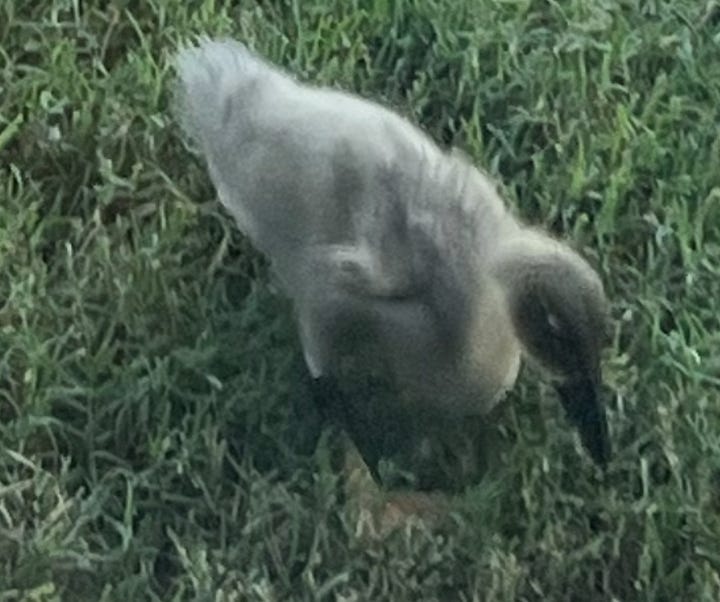
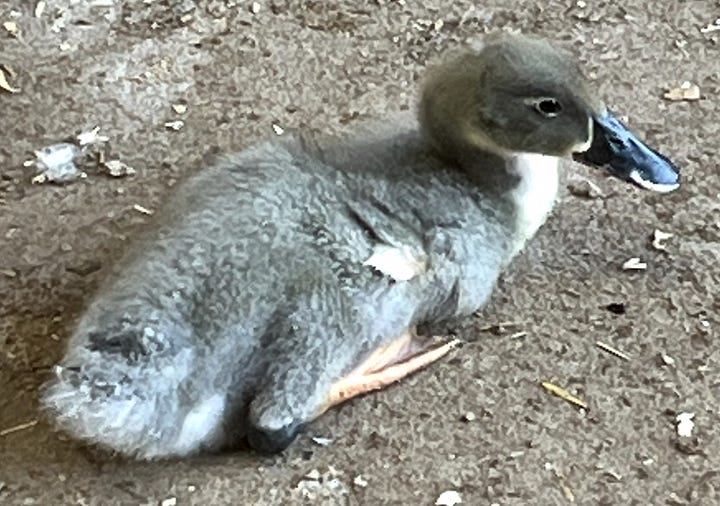
Paris and Gunner - Buff Mallard Females
Since the dna could not tell between Chocolate or Lilac Buff Mallard, it confirmed that the buff mallard females were easily distinguished at hatch as females, but since either color female works for my breeding program, it’ll still take time and hatch results to try and determine which is which. In the gallery below I’ve included other buff mallard females as well to see the feather development as they age:
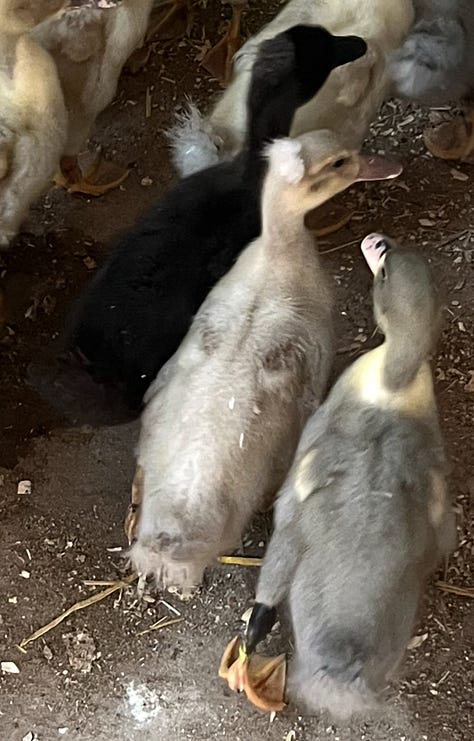
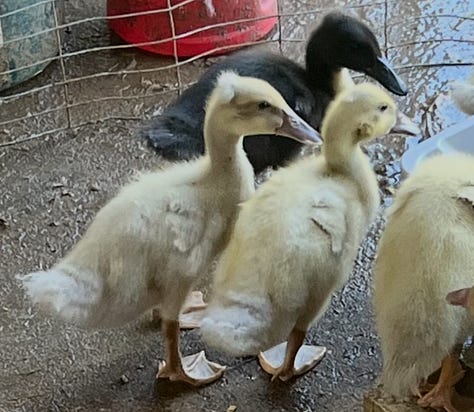
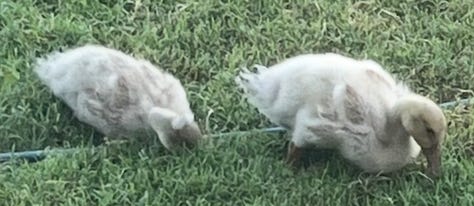
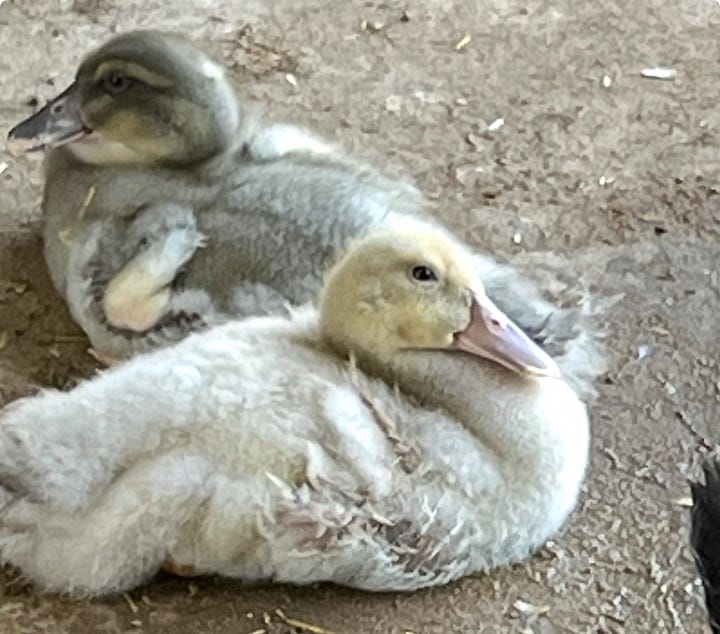
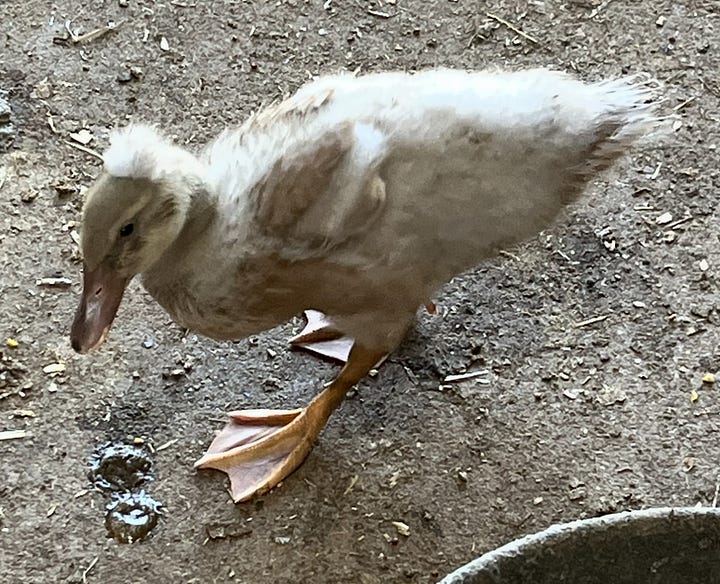
Last and probably least (especially in Wrexham’s case), the Crested Black Swedish developing juvenile feathering and the puzzling case that is Wrexham amongst her second duckling group. The non crested Swedish I hatched earlier was a large and bossy duckling I assumed male until she started quacking. She lost practically her entire white bib when her juvenile feathers came in. This younger and crested Swedish has kept its Bib although the edges are not as sharp as when it hatched. I didn’t dna test Wrexham, but am still considering her a Buff Mallard unless it’s a Mallard male very diluted. For now, Wrexham will remain with me since her growth is still very delayed compared to her age group. She’s been shuttled down to the next duckling group as her siblings were picking on her and twice her size. She does well with the younger ducklings and resists efforts on my part to separate her from their pen so she can free range, so back she went.
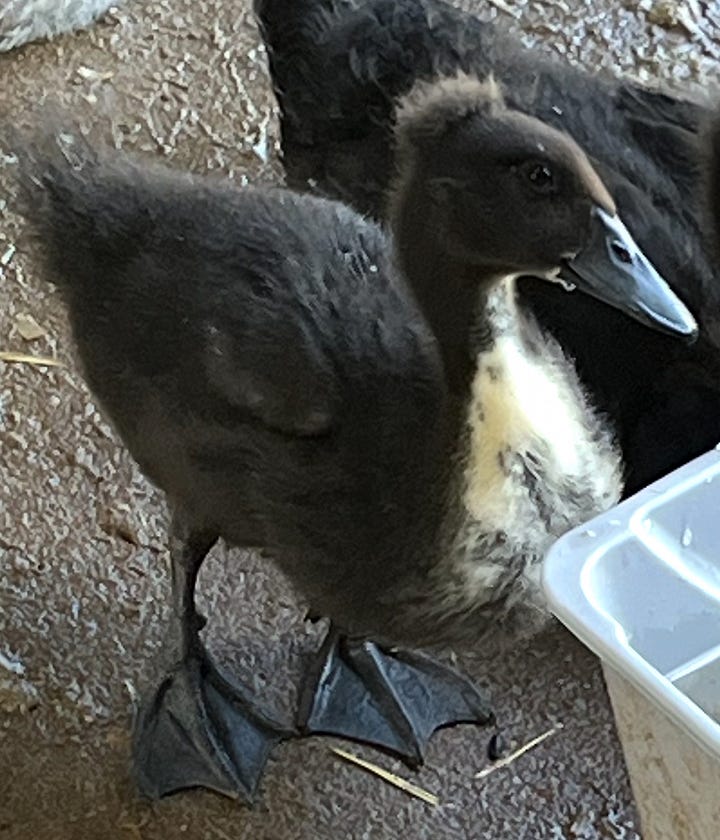
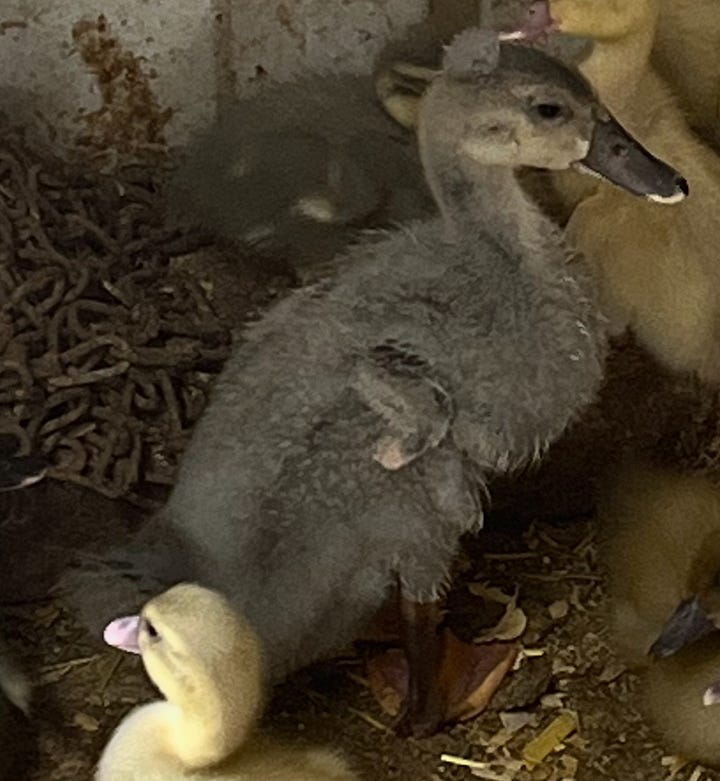
An interesting thing I noticed that requires more study is the low number of Crested females from these hatches. From a total hatched of 21 sex-linked crested eggs (excluding the Swedish), these are the maths:
Males: 9/21 or 43%. Crested males: 78% Non Crested males: 22%
Females: 12/21 or 57%. Crested females: 25%. Non Crested females: 75%
I don’t have a percentage of males and females hatched from a homozygous pairing like Metzer’s breeding strategy, so perhaps this is a normal ratio from a Crested and Non Crested breeding.
Thanks for joining me on this Crested duck breeding journey! I will likely update on a different post as this one is very long and image-heavy, but satisfying after many months of planning and dreaming!



